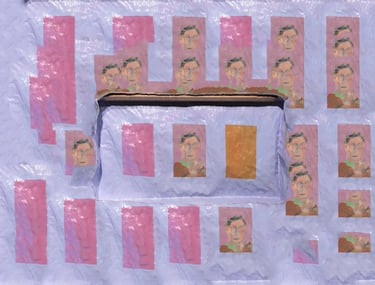Culinary Thinking: Francisco García
9/6/20183 min read
Food is so inherently coded into our identities that we oftentimes forget the ability that food possesses to comfort and restore ourselves. In this series of monthly interviews titled “Culinary Thinking,” Graphite editor Michelle Kim asks an artist what their favorite recipe is, as a reminder of the food we eat and the loved ones we share it with. For the month of September, Francisco García questions the border and it's consequences.
Francisco is an undergrad at UCLA studying art. His work explores regional and family history through internal geographies.
Michelle Kim: What do you make?
Francisco García: I consider myself somewhat of a dormant photographer. I haven’t really even touched a camera in a few months, but I think photography still centers a lot of the work I’m making now, and eventually I want to come back to it. This year I’ve mostly made videos.
MK: What informs your art making practice?
FG: A lot of my work is more or less directly informed by Southern California. I say Southern California but I really mean “Baja” which to me is the region between Ensenada and Los Angeles. I grew up in San Diego more or less sandwiched in between the border cities where my family came from and LA, where my dad was born, and where a lot of his extended family ended up.
The idea of a “border” never really got a chance to take root in my mind. I didn’t realize that that was a regional anomaly until I was applying to college, and it dawned on me that the majority Americans don’t share my views on the border.
Going to school in LA now I feel like parts of my regional perceptions are coming full circle and its something that I’m still trying to figure out how to navigate. I think thats the main theme thats shown up in my work recently. I want to let viewers know that the realities of the region are much more complex than they want to believe, and that I’m still working it out along side them.


MK: What is the significance of this recipe?
FG: This recipe means a lot to me because it was given to my grandma by my grandpa, who got it from a stand in Ensenada ages ago. It’s been tacked onto my grandmas kitchen bulletin board ever since even though I know that she’s memorized it by now, so the recipe is both a recipe, and an object.
MK: How do you believe this recipe relates to your work?
FG: A lot of people in San Diego will tell you that the Fish Taco is our “city food,” even non-Mexican people— but for me they stand for more than that. They represent how easily food can render a heavily militarized physical border useless. People will have different stories about Fish Tacos than I will, and that’s fine with me, I want those conversations and histories out in the open.


MK: What recipe have you decided to share with us?
FG: The recipe in the video is the recipe that my Grandma uses to make fish taco batter. Its a bit of a regional specialty from northern Baja into San Diego. There’s practically a mariscos truck on every corner in San Diego, but my favorite have always been at my grandmas house.
In an age where most Americans are perfectly complacent in the systemic dehumanization of the people who are put at risk by border policy, when Kirstjen Nielsen feels comfortable eating Mexican food after work but would probably shudder at the thought of talking to an actual Latinx person, recipes maintain a crucial sneakiness.
In some ways, food disrupts the mechanisms of a physical border. If people on the San Diego side want to claim something like a “fish taco” as a “city food”, suddenly it brings up the question, how do you even measure what is “ours” and “theirs”?
Is our notion of “us” and “them” geographic/ historical; decided by the shared regional history of Spanish colonialism? Is it biological; the waters where the specific type of fish in Ensenada can also be found on elsewhere up the coast? Political; where the US decided a border was after American land gains from the American intervention in Mexico?
Is it zoned by the educational systems; ending at the northern-most point you can find schools with students that commute every day into San Diego from Tijuana? Is it linguistic? Bound in family history or citizenship status? Food is really just the tip of the iceberg.
Ensenada Style Fish Taco Batter Recipe, as told by Francisco García:
Water
Flour
Pepper
Oregano, Finely Ground
Baking Powder
Generously coat strips of fish in batter, fry in skillet.
Warm up several fresh corn tortillas.
Slice lemons, radishes, and cabbage to garnish tacos.
Serve with fixings, salsa of choice, sliced avocado, pico de gallo, and Mexican crema or tartar sauce.
